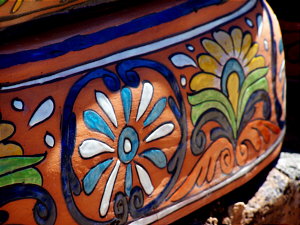



Nogales, Arizona
Back to our VisitTubac.com home page.
Some content courtesy of Wikipedia.
Other content provided by Richard A. Zidonis
Contact VisitTubac.com

 Nogales is a city in Santa Cruz County, Arizona, with a 2000 census population of 20,878. Nogales is also the
county seat of Santa Cruz County.
Nogales is a city in Santa Cruz County, Arizona, with a 2000 census population of 20,878. Nogales is also the
county seat of Santa Cruz County.
The name Nogales is derived from the Spanish word for "walnut," and the walnut trees which once grew abundantly in the mountain pass between the cities of Nogales, Arizona, and Nogales, Sonora, can still be found around the town.
Nogales, Arizona? Nogales, Sonora? Yes! Nogales, Arizona, borders the city of Nogales, Sonora, Mexico, and is Arizona's largest international border town. The southern terminus of Interstate 19 is located in Nogales at the U.S.-Mexico border. The highway continues south into Mexico as Mexico Federal Highway 15. The two towns are collectively known as "Ambos Nogales," or "both" Nogaleses.
The Arizona Nogales became an addition to the existing New Mexico Territory by way of the Gadsden Purchase in 1853. Congress ratified the acquisition in 1854, and the first survey crew passed through in 1855. The border marker between the two towns, at first a pile of rocks, became Border Monument 122 which is still in place today. More information about the border monument is located here.
According to the United States Census Bureau, the city has a total area of 20.8 square miles (53.9 km²), all of it land.
At an elevation of 3,865 feet, Nogales has a semi-arid steppe climate, which is less hot and more rainy than a typical arid climate classification. In the winter months, Nogales averages in the mid to upper 60s, with both January and February averaging daily highs of 64°F (18°C). Lows typically settle just below the freezing mark (32°F/0°C) on a majority of nights, but it is not uncommon to see temperatures tumble below 25°F (-4°C) on some winter nights.
In the summer months, highs average between 90°F (32°C) and 100°F (38°C), with the month of June being the hottest with an average daytime high of 96°F (36°C). Nighttime lows for the summer months remain in the upper 50s and lower 60s for the duration of the season. July and August typically see eight inches or more of combined rainfall, which brings the average annual precipitation for Nogales to about 19 in (483 mm).
Nogales' all-time highest recorded temperature is 112°F (44°C), which was reached on June 26, 1990. The all-time lowest recorded temperature that thermometers dipped to was -4°F (-20°C), which occurred on December 8, 1978.
Nogales was at the beginning of the 1775-1776 Juan Bautista de Anza Expedition as it entered the present day U.S. from New Spain, and the town is now is on the Juan Bautista de Anza National Historic Trail. On the second floor of the 1904 Nogales Courthouse is a small room dedicated to the 1775-76 Anza Expedition.
Most of Nogales' economy is based on agribusiness and produce distributors, which comes from large farms in the Mexican agri-belt. Despite its small population, Nogales actually receives much patronage from its bordering s ister-city, Nogales, Sonora, Mexico. Most observers guess the population of Nogales, Sonora, at roughly 300,000. International commerce is a big part of Nogalesí economy. More than 60 percent of Nogales' sales tax comes from Mexican shoppers crossing the border daily. Nogales, Arizona, and Nogales, Sonora, are home to one of the largest maquiladora clusters. This enables American manufacturing plants on both sides of the border to take advantage of favorable wage and operating costs and excellent transportation and distribution networks.
The Consulate-General of El Salvador in Nogales is located in Suite 3 at 840 North Grand Avenue. The Consulate-General of Mexico in Nogales is located on 571 North Grand Avenue.
The city of Nogales has a wide range of community facilities. These include nine parks, a museum, an art gallery, a movie theater, four recreation centers, four swimming pools, eight athletic fields, a library, six tennis courts and four golf courses. It has public elementary schools, middle schools, and high schools. Its financial institutions include six banks. Its governmental agencies include a staffed city and local fire department and a city police department. It is home to Nogales International Airport, which includes a 7,200 ft. runway and a terminal with a customs facility, passenger waiting areas, and a coffee shop. It has three regional health care facilities.
The county of Santa Cruz and the city of Nogales have 200 properties listed in the National Register of Historic Sites, including Tumacacori National Monument visited by Father Kino in 1691 and Tubac Presidio, established by the Spanish in 1752 on an Indian village site. Others include the Old Tubac Schoolhouse, Old Nogales City Hall, Santa Cruz County Courthouse, and Patagonia Railroad Depot. The Patgonia-Sonoita Creek Sanctuary, 19 miles east, attracts worldwide visitors to see its diverse bird life. It is also host to ghost towns and mining camps, curio shops, first-class restaurants and night clubs.
The Santa Cruz County Historical Courthouse on Morley Street/Court Street has the statue of Lady Justice on top of the building. Lady Justice is supposed to have a blindfold on holding the scales of justice. This symbolizes that justice is blind. The Nogales version of Lady Justice is not wearing a blindfold.
| Here's an interactive link to the Ambos Nogales area: |
View Larger Map |